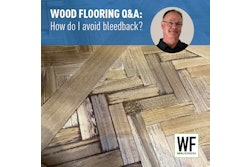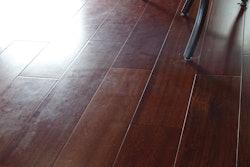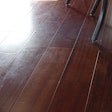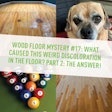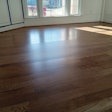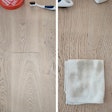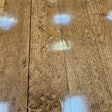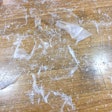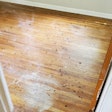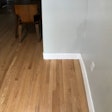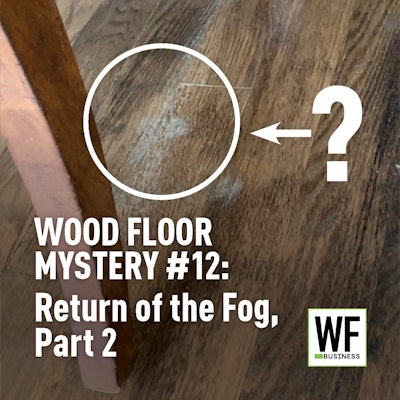
“It is an old maxim of mine that when you have excluded the impossible, whatever remains, however improbable, must be the truth.”
— Sherlock Holmes
Whether Sherlock Holmes solved his cases using deductive or inductive reasoning has long been debated. Many say he used both. The commonality is that both are used to formulate inferences: conclusions based on proven and acceptable facts and premises. This is my approach when inspecting a floor or solving these wood flooring anomalies I like to call “mysteries.”
Take Mystery #12, for example (see “Wood Floor Mystery #12: Return of the Fog!”). The original assumption upon visual inspection is that the finish looks “foggy,” as you can see here:

Floor pros, as expected, went straight where I did: Was the stain a failure? Is there moisture involved? Did the contractor rush the coatings?
I eliminated these suggestions because Tim, the floor pro involved, said that after he had completed the work, there were no issues for weeks, and had he been paid upon completing the work. The work was therefore acceptable to all involved before this anomaly appeared. This, to me, eliminates contractor error and manufacturers’ defects. The issue here is what I call an LCC, a “locally caused condition.”
Clue #1: Something’s Missing in the Photo
During COVID I did a lot of inspections via Teams, Zoom, FaceTime, email, text, and phone conversations. I’ve learned to gather the same information electronically that I would via a job-site inspection.
In the photos Tim texted, it struck me there was a dining table with a “cabriole” leg. I began my career as a woodworker and furniture-maker, so this photo got my mind spinning like the pedals on a downhill tricycle. Welcome to my mind: Put your hands and feet inside the vehicle, fasten your seat belts, it’s gonna be a bumpy ride!
The cabriole leg is ornate, and with the deep English Tudor coloring, the table seemed to clash with the dining room. It didn’t quite fit. Was it a gift or inheritance? Very nice piece, but to me, out of place. Would I serve dinner on that? Wait … what are most dining rooms used for? Answer: Accounting. We remodeled our dining room and kitchen to create a more open concept. Now, what do we use our dining room for? Accounting. We STILL use the dining room table for computer work, writing, paperwork, paying bills … it’s become a glorified six-chaired desk with candles. The newly opened dining room is attached to our kitchen, which now has an island, which is now our dining table! You get it.
Recalling that we mainly use our dining room more as an office than to entertain, and that we typically use one chair at the head of the table, I thought: Was one person repetitively using the chair where the floor looked damaged? That’s what was missing … there are no chair legs in the photo! One lonely cabriole table leg. Where are the chairs?
I called Tim and asked him to FaceTime me so I could do a virtual walk-though of the job site. Once I had live video, I could spot five chairs. The only one missing was the one directly at the head of the table where the foggy finish was.
Clue #2: Confirmation Bias
Recall my rant in Part 1 of this mystery about confirmation bias? That’s when someone looks for, supports, recalls, and presents information based on their own prior opinions. If the missing chair caused this, where is it? Was it removed on purpose? Could someone be diverting attention and withholding information in order to support someone’s preconceived notions?
Back to the photo…
Is this just wear and tear? If these marks are scuffs from the chair legs, why are they a few inches askew and not lined up neatly—the front of the chair would be leaving marks wider than the rear legs. Oh wait … the cabriole legs!
I asked Tim to pan the room with his cell phone camera, and at the other end of the home, I saw another room with furnishings. Before I could say anything, Tim shouted, “Here it is!” as we both spotted the missing chair a long way from the dining table where it belonged.
I asked Tim to put the chair back in place and instantly the mystery was solved … almost:
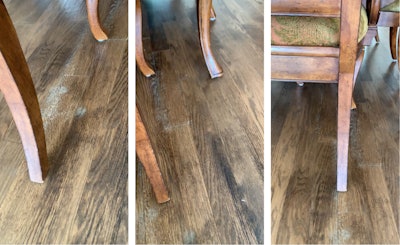
The four legs of the chair lined up exactly with the “foggy” spots on the floor. The cabriole legs were spaced wider in the front than the rear, making the match even more incriminating. We found our smokin’ chair! But why white, foggy, cloudy patches?
Tim told me he had lightly sanded and coated the patches with the original oil polyurethane thinking that if the poly had been scuffed and powdered, it would blend with fresh poly, but it didn’t. Tim must have been coating over a contaminant. But under a table leg?
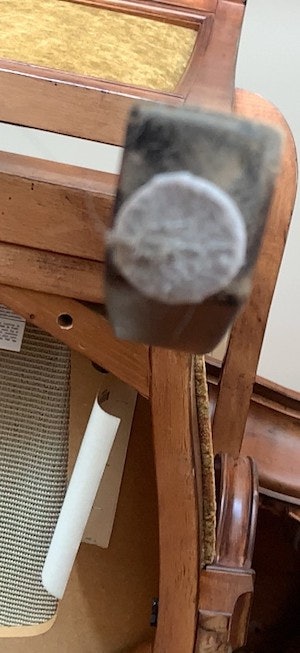
Cognitive vs. confirmation bias?
Cognitive bias is the error in thinking that occurs when people use their own confirmation bias to steer opinions and results their way.
My clue from the narrative involving my pet peeve of confirmation bias was introduced as it appeared to me, possible, that whoever moved the one dining room chair didn’t do that to be helpful. They had likely seen the worn floor pads, knew what had happened, and conveniently and literally took the evidence off the table … or, in this case, the floor.
There were no scuff marks under any of the other chairs, and those floor protectors were pristine. This was not a dining room. it was an Accounting Department! Either that’s one expensive six-chaired desk, or someone is eating a lot of lonely meals at that table! That chair HAD to go!
Ask anyone that inspects flooring, handles claims or customer returns, and they will tell you that getting to the truth of the matter often takes a wildly circuitous route. From the big box “You break it, just return it” generation to today’s online, “If you don’t like it, just return it” times, it seems whatever gets the consumer straight to the “total warranty, not-my-bad, free pass to anything and everything solution” is the starting point.
When I inspect a floor, I use two philosophies:
Be Fair But Firm
The Floor Always Tells The Story
I dissuade anyone from discussing their flooring situation with me until after I inspect everything myself. This establishes credibility. Working to formulate technical, scientific, and reasonable solutions to situations like a wood floor inspection becomes very difficult when parties involved have already framed and presented their own “professional” opinions.
An inspector’s job is not to point fingers, assign blame, take sides, or toe the company line; it is to formulate reasonable and effective solutions for all involved. Solutions, not verdicts, are the key. A beautiful wood floor for the consumer is our focus, not setting a court date.
The solution to Wood Floor Mystery #12: Return of the Fog? Tape off the the area damaged at board edges. Sand with the exact same process as used originally. Pop the wood as before, stain and blend. Coat precisely the same as originally performed. Pull the tape when dry, and, for good measure, abrade and coat the entire floor. Problem solved.
The flooring mysteries keep rollin’ in, so strap on your floor expert helmets and add Wood Floor Business and the “All Things Wood Floor” podcast to your search bar favorites, because we are just getting started!
See all of Stephen Diggins' Wood Floor Mysteries and more here.















